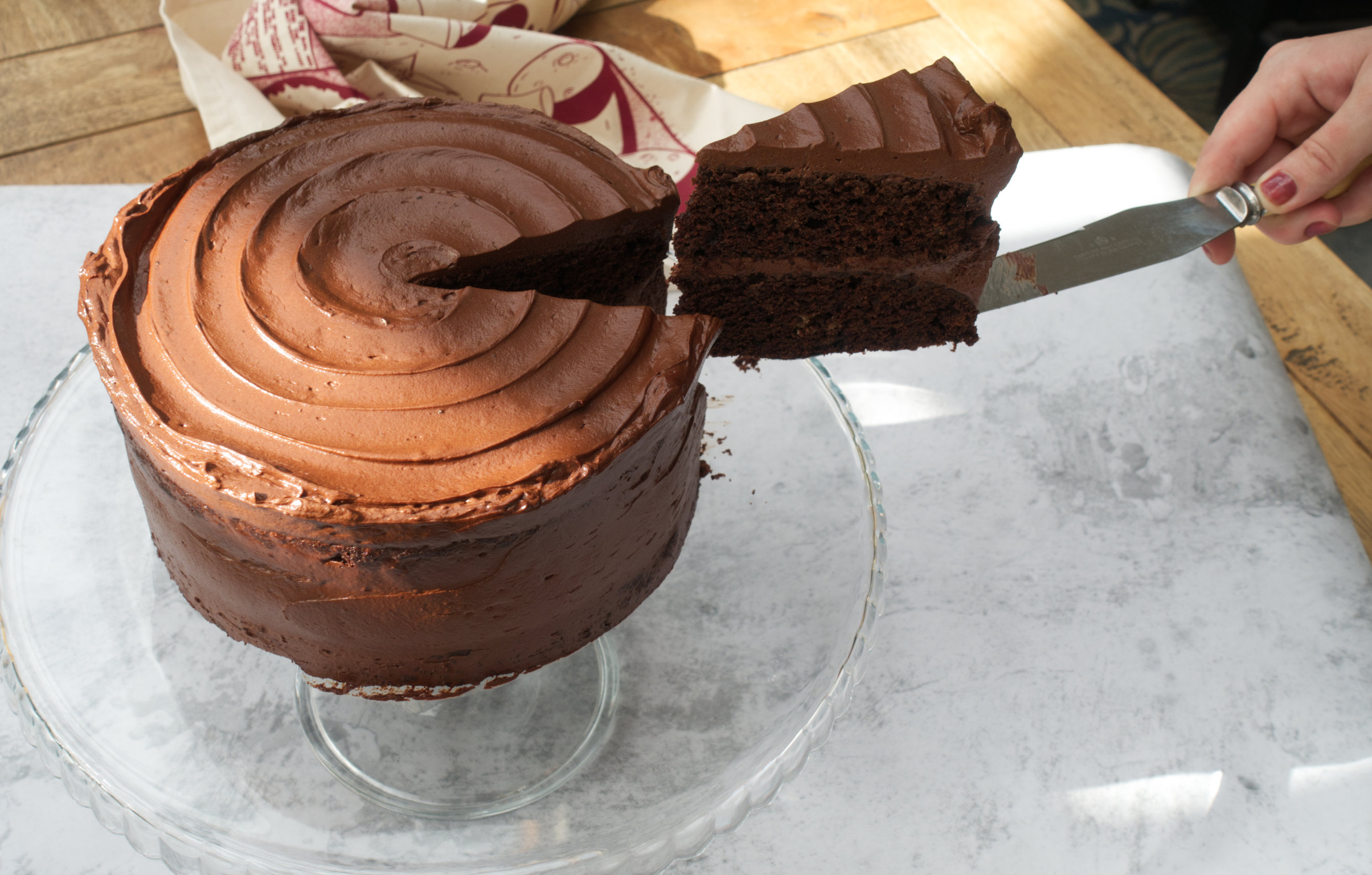Chocolate cake comes in many different guises: from the dark and rich, to the sweet and simple. For me, it’s not like the ultimate cookie, or the perfect brownie: I don’t believe that there is one, definitive chocolate cake. I do not spend my days searching for the platonic version; trying to rank a chocolate fudge cake above or below a a cream-filled Yule log or a chocolate chunk-studded, plain loaf cake is like comparing apples and oranges.
I think, instead, that there is a perfect chocolate cake for every mood. For a party, I want something crowd-pleasing, sweet and tender, with old-fashioned milk chocolate icing; it must cut cleanly, and not crumble. If it’s mid-morning, and I’m already thinking about chocolate cake, it’s probably a dinky little Swiss roll, one of those kid sized ones that comes individually wrapped, and sits in my cupboard, just waiting for its rightful place, next to my 11 o’clock coffee. Sometimes I want a tall, thin slice of something impossibly indulgent, sometimes I want something I can have two (and a half) slices of without feeling queasy. Some days I want it with caramel, or malt, or peanut butter. If I’m by myself, I just want a slab of Nigella’s chocolate, tahini and banana loaf.
The devil’s food cake is its own category: richer than most other chocolate cakes, thanks to a high proportion of melted chocolate in the mixture. It’s a layered cake, with those thick layers of damp sponge sandwiched with an equally rich and thick icing. This is quite a grown-up cake. Put it this way: it’s not going to be replacing Colin the Caterpillar at children’s parties any time soon. But if you want a beautiful and impressive cake to serve on elegant plates to those with slightly more mature palates (no disrespect to Colin; as aforementioned, there is a time and a place for him), then this is the cake for you.
It’s not certain where the hellish name comes from: some suggest it’s a nod to its indulgent and bittersweet nature, or perhaps it came from the unusually dark colour of sponge that the combination of cocoa and bicarbonate of soda bring, a devilish black. Or maybe it was simply named in contrast to the bright white, lightness of angel food cake.
Whatever the origin of its name, the cake is characterised by its high chocolate and cocoa content, making it, well, extremely chocolatey. Boiling water is often added to this style of cake, instead of milk, which can mellow the sharp, rich flavours of the dark chocolate. The boiling water also helps the complex flavour of the cocoa powder bloom, and I add a little instant coffee to the boiling water to further enhance those bittersweet chocolate notes.
The icing is incredibly easy to make, but acts like the fanciest ganache or Swiss meringue buttercream: all the ingredients are heated together gently until combined and glossy, then left to cool, before being whisked vigorously until pale and smooth. Whisked, it becomes almost like a proper chocolate mousse, luscious, and bittersweet, and very, very chocolatey.

Devil’s Food Cake
Makes: 1 tall 8 inch cake (serves 10)
Takes: 30 minutes, plus cooling
Bakes: 30 minutes
For the sponge
150g butter
100g dark chocolate
150g light muscovado sugar
100g dark muscovado sugar
50g cocoa powder
250ml boiling water with 1 tablespoon instant coffee
1 teaspoon vanilla paste
2 eggs, beaten
1 egg yolk, beaten
250g plain flour
½ teaspoon baking powder
½ teaspoon bicarbonate of soda.
1 teaspoon salt
For the icing
250g butter
60g dark brown sugar
25g cocoa powder
100ml water
200g dark chocolate
- Preheat the oven to 160°C and grease and line two round 8 inch cake tins.
- In a pan over a low heat, melt together the butter and dark chocolate until smooth, then add the two sugars, cocoa powder, boiling water with coffee and vanilla paste, and stir to combine. Allow to cool for five minutes, then stir through the eggs and egg yolk.
- Fold through the flour, baking powder, bicarbonate of soda and salt, then divide the mixture between the two prepared tins. Bake for 30 minutes until the sponges are risen and, when pressed gently with a finger, spring back.
- Meanwhile, make the icing. In a pan, gently heat the butter, sugar, cocoa powder, water and dark chocolate together, whisking to combine. Set to one side to cool completely.
- Once the sponges are baked, leave them to cool for 15 minutes, then remove from the tins, and leave to cool completely.
- In a stand mixer, or using electric beaters (or a hand whisk and some elbow grease), whisk the cooled ganache, slowly at first, and then faster, until it is increased in volume and paler than when you started.
- Remove any greaseproof paper from the base of the two sponges, and place one on a plate or cake stand. Spoon a third of the icing onto the sponge and smooth to the edges in a thick layer, and place the second sponge layer on top. Smooth the rest of the icing onto the top and sides of the cake. The cake will last well for 4 days.







Comments